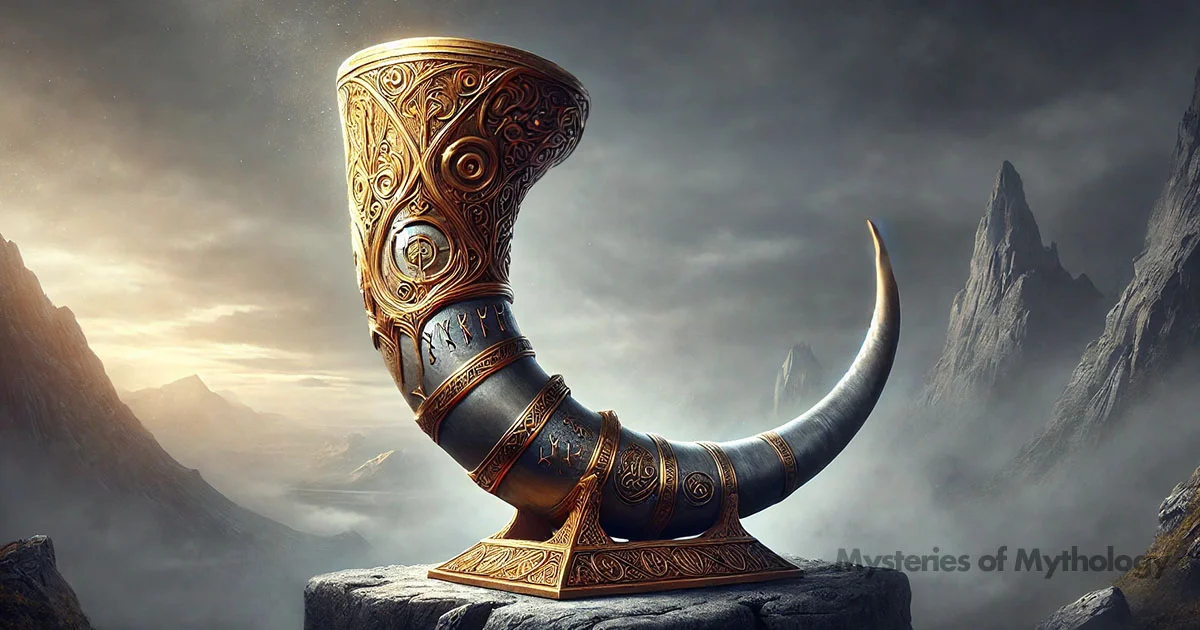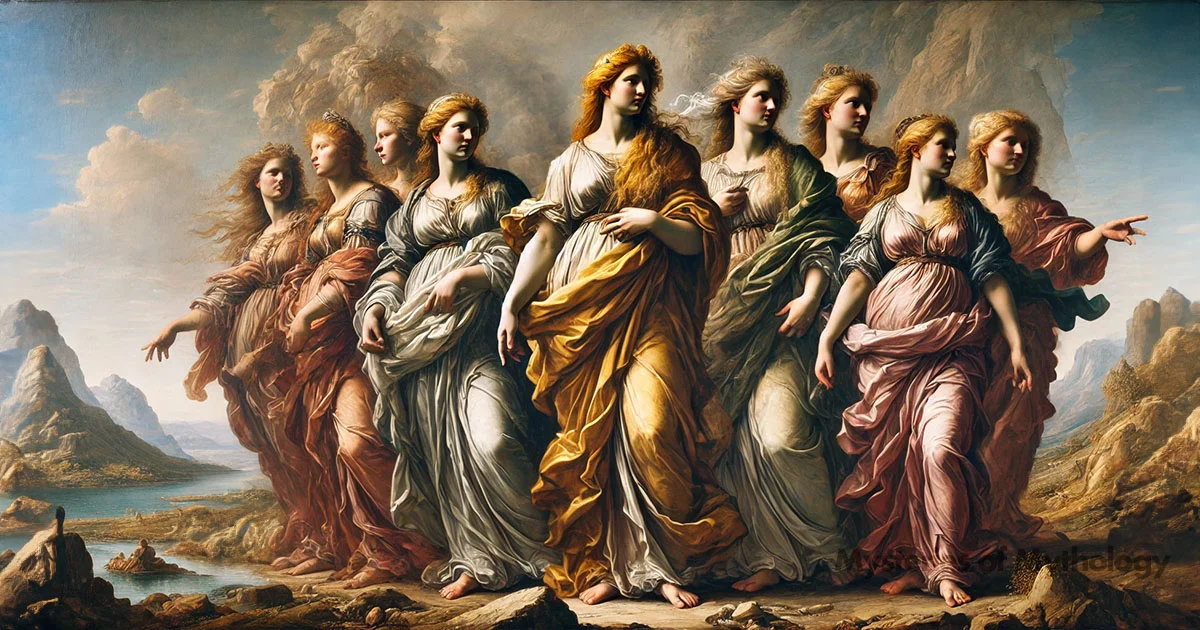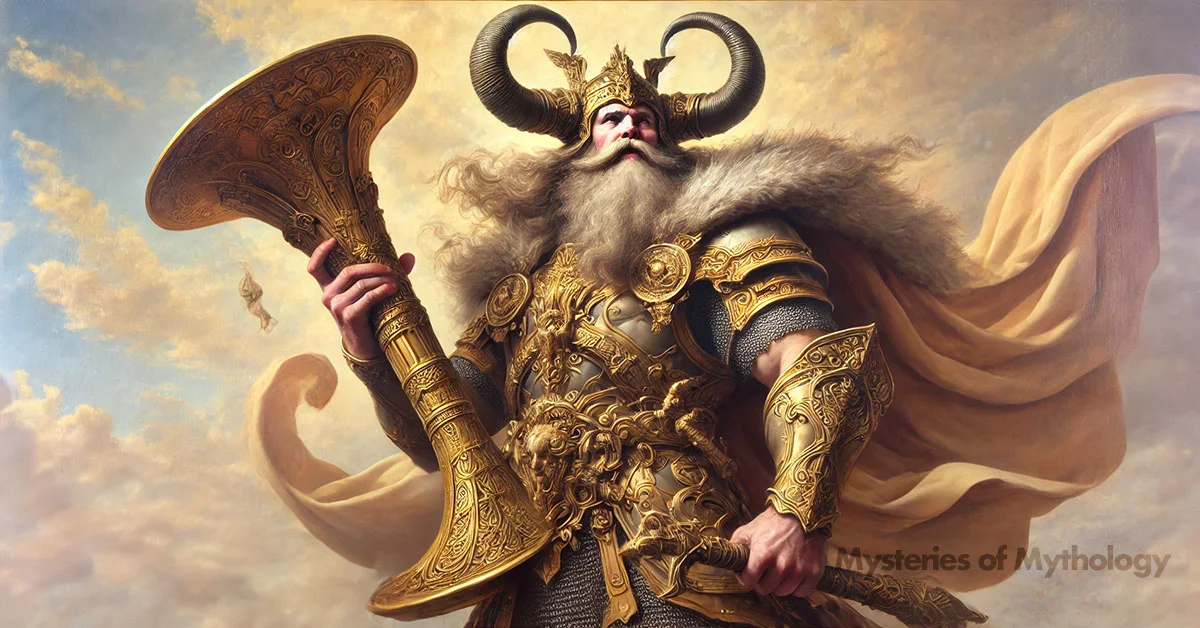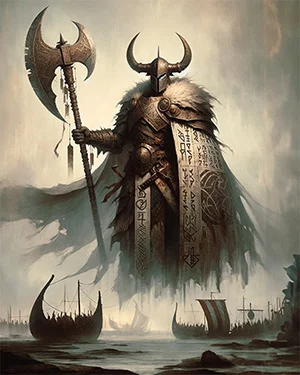Overview
Heimdall was the ever-watchful guardian of the Bifröst Bridge in Norse mythology. Known for his incredible senses, he could hear grass growing in the fields of other realms and wool growing on sheep. He could see for miles around him and into different realms, even in the dark.
As the son of nine mothers, he had unique strengths. Heimdall’s primary duty was to protect Asgard and its residents from any threats, such as the Jötnar giants (who weren’t all giants). He stood patiently waiting at the gates of Asgard with the Gjallarhorn, which was prophesied that he would blow to signal Ragnarök, the end of the world. He was also known for sleeping with married human women while their husbands slept next to them.
Want to know more? Read on…
Watch the related video
Etymology
Heimdall’s name comes from the Old Norse “Heimdallr,” which possibly means “the one who illuminates the world.” The exact etymology remains unclear but is often associated with light and protection.
Pronunciation
ENGLISH
Haimdall
Old Norse
Heimdallr
PHONETIC
HAYM-dahl
IPA
/ˈhæɪmˌdɑːl/
Alternate Names
Heimdall is also known by several other names, including Hallinskiði, Gullintanni (meaning “Golden Teeth”), and Vindlér or Vindhlér, which translates to “the one protecting against the wind” or “wind-sea.” He is sometimes called Rig, especially in the context of the Rígsþula, a poem in which he fathers the classes of humanity. He is also known as the “White God” due to his purity and brilliance.
Attributes
Heimdall was known as the watchman of the gods. His heightened senses and ability to see into the future made him perfect for this job. He could see for hundreds of miles by day or night, and his hearing was so sharp that it was said he could hear the grass growing on the ground and wool growing on sheep. He was also said to need less sleep than a bird, which made him the perfect guardian.
At his side rested the Gjallarhorn, a horn whose blast was so deep that, when sounded, its echo reached every one of the nine realms. Gjallarhorn simply means “loudest horn.” He would blow this horn to announce intruders, but in the end, he only blew it once for the coming of Ragnarök, the end of the world. In some versions, Heimall was said to have a horse named Gulltoppr, which had a beautiful golden mane.

There’s a notoriously vague section in the poem Völuspá about Heimdall’s hljóð, which could mean his hearing, horn, or ear, which is buried under the world tree Yggdrasil. This could be a physical burial of the horn or his ear, and if so, that might be associated with how he gained his powers, like how Odin sacrificed his eye for wisdom. Or, perhaps it could just show his connection to the cosmos.
Heimdall lived in a castle in the clouds called Himinbjörg, which means “heaven’s castle.” This castle was at the end of a rainbow bridge called Bifröst. In his castle, Hemdall was said to brew the finest mead. In the Grímnismál of the Poetic Edda, Odin described Himinbjörg as one of the most incredible places in Asgard:
“Himingbjorg is the eight, and Heimdall there O’er men hold sway, it is said; In his well-built house does the warder of heaven The good mead gladly drink.”
(“Grímnismál,” st. 13.)
The Bifröst bridge connected Asgard, the home of the gods, to Midgard, the home of humans.
There has also been some debate on whether Heimdall was one of the Vanir gods because of his magical foresight abilities. Still, there haven’t been any direct indicators in the mythology. As we’ll see in the family section below, he has more to do with the Jötun than the Vanir.
Family
Heimdall was one of Odin’s many sons, but his birth was unique. He had nine mothers, all of whom were sea maidens or water giants, each representing one of nine types of ocean waves. Their names were Gjolp, Greip, Eistla, Eyrgjafa, Ulfrun, Angeyja, Imth, Atla, and Jarnsaxa. Some scholars think his mothers might be the nine daughters of the sea giant Ægir. However, the names of Heimdall’s mothers do not match Ægir’s daughters, making this theory difficult to prove. Nine was a powerful number associated with the Nine Realms of the Norse Cosmos.
“One there was born in the bygone days, Of the race of the gods, and great was his might; Nine giant women, at the world’s edge, Once bore the man so might in arms. Gjolp there bore him, Greip there bore him, Eistla bore him, and Eyrgjafa, Ulfrun bore him, and Angeyja, Imth and Atla, and Jarnsaxa. Strong was he made with the strength of the earth, With the ice-cold sea, and the blood of swine.”
(“Hyndluljóð,” st. 37–39.)
Through his father, Odin, Heimdall had several half-brothers. These included well-known gods like Thor, Vidarr, and Váli. He was also related to other important gods such as Tyr, Bragi, Hermod, and Hodr.
If Heimdall’s grandfather was Ægir, then he would be at least 3/4 Jötun, as Odin was half Jötun as well.

Unlike many other gods, Heimdall didn’t have any wives or partners with the other gods. However, he did have children with humans. According to an old Norse story called the Rígsþula, Heimdall’s children became the ancestors of human society’s three main social classes.
Family Tree
Parents
Father
Odin
Mother
The Nine Mothers
Siblings
Brothers
Baldur, Bragi, Hodr, Thor, Tyr, Váli
Vidarr
Mythology
Early Life
Heimdall’s origins are shrouded in mystery. Some scholars suggest he may have connections to ancient Indo-European deities, possibly linked to his association with rams, though this remains speculative. What’s clear is his significant role in Norse mythology, particularly in the creation of human social classes.
The Rígsþula, an Old Norse poem, recounts how Heimdall, disguised as a human named Ríg, established the social hierarchy. The poem describes Ríg’s journey:
“Men say there went by ways so green
Of old the god, the aged and wise,
Mighty and strong did Rig go striding.”(“Rígsþula,” st. 1.)
Ríg visited three households, spending three nights in each. In every home, he shared his wisdom. In what seems a strange situation, Ríg would sleep in the same bed as the husband and wife of the home and secretly fathered a child with the wife. These children became the progenitors of three distinct social classes:
- Thræll (meaning “slave”): An ugly brute with knotted hands, ancestor of the thrall or slave class.
- Karl: A sturdy boy with a ruddy face, the forefather of free farmers and labourers, or the middle class.
- Jarl: A blonde boy with shining eyes and a thirst for adventure and war, a progenitor of the nobility or aristocratic warriors.
The poem continues with Jarl having a son named Kon, who embodied lordly qualities. Ríg adopted Kon, teaching him the mysteries of runes and grooming him for kingship. The Rígsþula served more than just as an entertaining story.
It played a significant role in reinforcing the existing social order in Norse society. By linking the creation of social classes to a divine act performed by Heimdall, the myth legitimized the roles and privileges of each class. This concept of ‘divine right’ helped maintain social stability and ensured obedience to the established hierarchy.
Loki and Heimdall’s Antagonism
In Norse mythology, Loki, the notorious trickster, once managed to steal Brísingamen, the dazzling necklace of the goddess Freyja. Always up to no good, Loki thought he could get away with it, but he underestimated Heimdall, the ever-watchful guardian of the Bifrost Bridge.
Heimdall’s Role in Thor’s Adventures
Heimdall’s wisdom and foresight are highlighted in the Þrymskviða, a poem in the Poetic Edda. When Thor’s hammer was stolen by Thrym, the giant king of Jötunheimr, Heimdall provided the solution. After Loki discovered that Thrym would only return the hammer in exchange for Freya, Heimdall suggested dressing Thor as Freya to trick the giants:
“Then Heimdall spake, whitest of the gods,
Like the Vanir he knew the future well:
‘Bind we on Thor the bridal veil,
Let him bear the mighty Brisings’ necklace;
Keys around him let there rattle,
And down to his knees hang woman’s dress;
With gems full broad upon his breast,
And a pretty cap to crown his head.'”(“Þrymskviða,” st. 14.)
Heimdall’s plan succeeded, allowing Thor to retrieve his hammer and slay the giants. The poem suggests that Heimdall, with his ability to see the future, knew this plan would work.
Heimdall’s Part in Ragnarök
Heimdall played a crucial role in Ragnarök, the apocalyptic battle that would lead to the death of the gods and the destruction of the world. As the ever-vigilant guardian, Heimdall was destined to be the first to see the onset of Ragnarök. When he witnessed the giants and monsters approaching, he would sound his horn, the Gjallarhorn, whose blast would resound through all Nine Worlds, alerting the gods to assemble for their final battle.
During this cataclysmic event, Heimdall was fated to confront Loki. And for some unknown reason, Hemdall wore Brísingamen, the dazzling necklace of the goddess Freyja, that Loki stole earlier. Having been severely punished for his role in Baldr‘s death, Loki had switched allegiances and would fight alongside the giants. The two were destined to slay each other in a final epic duel once again in the form of seals.
A cryptic verse describes their conflict:
“The famed rainbow’s defender,
Ready in wisdom, striveth
At Singasteinn with Loki,
Fárbauti’s sin-sly offspring;
The son of mothers eight and one,
Mighty in wrath, possesses
The Stone ere Loki cometh:
I make known songs of praise.”(Sturluson, “Skáldskaparmál,” p. 115.)
Pop Culture
While Heimdall was less popular when people first became interested in Norse myths again in the 1800s and 1900s, he’s become much more well-known recently thanks to Marvel Comics and movies.
In Marvel’s version, Heimdall keeps his main abilities from the old myths. He can still see and hear everything happening in all Nine Worlds, and he guards Asgard (home of the gods) and the Bifrost (rainbow bridge).
In the Marvel movies, Heimdall is played by actor Idris Elba. This casting choice helped make Heimdall much more famous and recognizable to modern audiences. Marvel stayed true to the basic idea of Heimdall from the old stories, but added new adventures and details to make him more interesting for today’s viewers.
Beyond Marvel, Heimdall has appeared in various other modern interpretations:
Video Games: Heimdall features in games based on Norse mythology, such as “God of War” (2018) and “Assassin’s Creed Valhalla” (2020).
Literature: Modern retellings of Norse myths, like Neil Gaiman’s “Norse Mythology” (2017), have helped introduce Heimdall to new audiences. In these works, authors often expand on Heimdall’s character while trying to stay true to the original myths.
TV Shows: The History Channel’s series “Vikings” includes Heimdall among its pantheon of Norse gods, though his role is minor compared to other deities.
Music: Some modern Nordic and Viking metal bands reference Heimdall in their lyrics, tapping into the renewed interest in Norse mythology.
Frequently Asked Questions
What is Heimdall the god of?
Heimdall is the Norse god of vigilance and the guardian of the Bifrost, the rainbow bridge connecting Asgard to Midgard.
Is Heimdall more powerful than Thor?
No, Thor is generally considered more powerful than Heimdall. Thor is the god of thunder and one of the mightiest gods in Norse mythology.
How is Heimdall killed?
Heimdall is killed during Ragnarök, the end of the world in Norse mythology. He and Loki kill each other in their final battle.
What race was Heimdall?
Heimdall is considered an Aesir, a race of gods in Norse mythology. However, he also has Jötun heritage.
How is Heimdall related to Odin?
Heimdall is considered to be a son of Odin, making him a brother to gods like Thor and Balder.
References
“Grímnismál.” Poetic Edda. Translated by Henry Adams Bellows.
“Hyndluljóð.” Poetic Edda. Translated by Henry Adams Bellows.
“Rígsþula.” Poetic Edda. Translated by Henry Adams Bellows.
Turville-Petre, E.O.G. 1964. “Myth and Religion of the North: The Religion of Ancient Scandinavia.”
Simek, Rudolf. 1993. “Dictionary of Northern Mythology.” Translated by Angela Hall.
Sturluson, Snorri. “Skáldskaparmál.” Prose Edda. Translated by Arthur Gilchrist Brodeur.
“Þrymskviða.” Poetic Edda. Translated by Henry Adams Bellows.
“The Norse Myths” by Caroline Larrington
Turville-Petre, E.O.G. 1964. Myth and Religion of the North: The Religion of Ancient Scandinavia.



